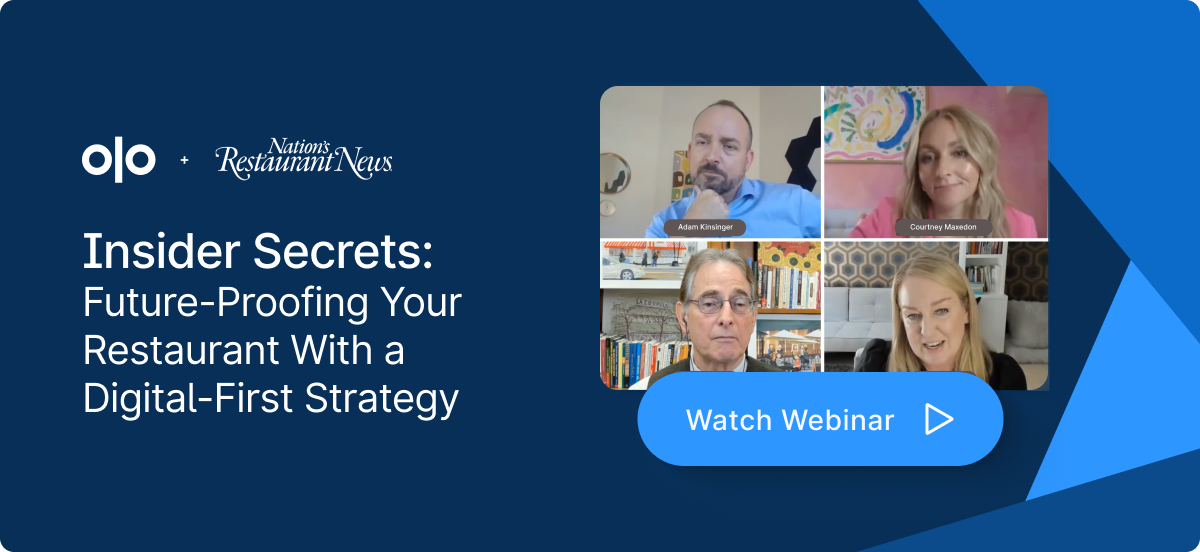
This article outlines:
The pros and cons of building custom restaurant software
5 questions to ask before deciding to build vs. buy
How to avoid the sunk-cost fallacy: Pei Wei case study
There are a lot of factors outside of a restaurant brand’s control—rising food costs and competition to name a few. And yet, the one thing you can control is the guest experience.
We’re not just talking about on-premise, either. According to the National Restaurant Association, 16% fewer people are dining in-restaurant today compared to pre-pandemic levels.
To meet the needs and expectations of digital-first guests—on-premise and off-premise—all types of restaurant brands are racing to update and optimize their tech stack.
Given the industry is still in the early innings of its digital transformation, brands often find themselves navigating a mix of legacy tech and newer tools that can be hard to connect.
For smaller, emerging brands, buying restaurant software from tech vendors is usually a no-brainer. But for larger, more resourced brands, the debate can shift to build vs. buy or build and buy.
What’s Attractive About Building Custom Restaurant Software
The power of building native technology lies in owning the roadmap and defining the priorities—restaurant brands can determine exactly what matters and build it, even if they’re the only brand in the world that values those capabilities. This level of control is alluring, especially for bigger brands, that might have more resources to take on a custom build.
Additionally, working with external software partners can get complicated. For one, some tech vendors control restaurants’ guest data. A scaling tech company may also get sold to a large corporation only for the tech roadmap and overall priorities to change. Even more simply, many tech partners fail to deliver on promised updates or oversell the future.
And, through it all, tech solutions cost money for restaurant brands that famously operate on razor-thin margins.
The Trouble With Building Custom Restaurant Software
Despite the best intentions of building custom restaurant software, brands often find themselves in a quagmire. Restaurants don't specialize in tech.
Even companies like Lyft and Airbnb use Amazon Web Services (AWS). Why? Because specialization makes for a better outcome. A business that specializes in a solution will put the needed resources, rigorous testing, and a world-class team of engineers behind it.
Lyft leverages AWS for its IT infrastructure, data center capacity, etc. so it can focus on building the parts of its product that are differentiated.
The same principle applies to restaurant brands. The need for a POS system or reservations platform is commonplace across the entire industry—execution of the food and guest experience is each brand’s differentiator.
5 Questions to Ask Before Deciding to Build vs. Buy
1. Will the short- and long-term costs be justified?
For restaurant brands, it’s difficult (if not impossible) to match the operational focus of a tech company intent on building software products that will be resold to thousands of customers. Tech companies invest their time, money, and resources into product design, engineering, maintenance, and optimization to stay competitive in their verticals.
To build a custom software application, a restaurant brand could put a year’s worth of SaaS fees or more into development—while paying a tech partner to keep day-to-day operations running in the meantime—and still not do a better job than a tech partner. And, because the work isn’t ever “done” once a solution is rolled out, the investment doesn’t stop there.
Marginal value invested in the restaurant software application often doesn't justify the marginal cost, because brands are limited on the number of restaurants they can create value for.
2. Can you compete with tech companies to attract and retain top talent?
Because the economics are better for tech companies, they naturally attract talent. Engineers gravitate to companies where they are paid the best. In addition to large salaries, tech companies often provide equity.
On the other hand, restaurant brands have more complex environments—they need ops, culinary, real estate, marketing, and training, in addition to technology.
Beyond the talent aspect, partnering with a restaurant tech company allows you to tap into the knowledge base of a wide range of customers and their guests, integration partners, and a variety of specialists—all in the name of building the best possible solution for an entire industry. A restaurant team building in-house is limited to input from a much smaller pool of experts.
3. Will building tech take focus and resources away from what matters most to your brand?
Werner Vogels coined the term “undifferentiated heavy lifting” to describe all the hard work engineers do that doesn’t add value to the company. This concept inspired Amazon’s development of AWS. Jeff Bezos put it this way, “we build muck so you don’t have to.”
In discussing this theory, Arun Nagarajan, Chief Product and Technology Officer at Evolve and a founding member of Uber Eats, laid it out simply, "building anything is hard. There are things you probably don’t want to build because it doesn’t matter who builds it. If you’re lifting heavy things anyway, lift the things that matter."
Building a memorable, authentic guest experience is what matters most for restaurant brands, and it is already a heavy lift. Shifting focus to building the technology behind those guest experiences may result in resources being spread too thin.
4. Can guests wait for mission-critical systems to be built?
If a tech solution is a priority and will solve a unique problem for your restaurant business, what is the cost of delaying implementation while it’s built internally?
By the time a tech company finds product market fit, they’ve gone through upwards of five iterations of their product, with rigorous testing, bug fixes, and multiple rounds of addressing user feedback.
Buying a solution comes with hard-earned ease of use, advanced features, product stability, and ongoing support from day zero. Building custom software means likely having one-fifth of the capabilities and ROI on day 365.
Equally as important as time to value is the consideration of points of potential failure once a system is rolled out. Leveraging an outside tech vendor offers risk mitigation against a scenario in which an internal employee exits a company and takes intricate knowledge of a proprietary system with them. (And, a new in-house engineer stepping in could take 3–6 months to ramp.)
5. Beyond the dollar amount, how high is the opportunity cost?
The time spent waiting for a homegrown solution to be ready is not the only cost. The likelihood that it will be underdeveloped compared to existing solutions is high. This may result in missed value that would have come from having a tech partner that drives results immediately.
There is also a real probability that a custom-made solution won’t seamlessly integrate with other technologies used by the brand or crucial value-added features. In addition, the difficulty in keeping up with the industry’s evolution at pace will put brands exponentially further behind their competitors. All of this increases opportunity cost long-term.

Avoiding the Sunk-Cost Fallacy: Pei Wei Case Study
Answering those upfront questions can help you avoid some costly missteps that make it increasingly difficult to course-correct over time. Too often, once material investments are made, brands fall prey to the sunk-cost fallacy and continue iterating on systems that could more easily be replaced with proven solutions already in the market.
Pei Wei, a fresh Pan-Asian fast-casual restaurant, faced this problem head-on when it saw digital sales decline due to the underwhelming performance of its homegrown ordering solution. Rather than continuing to invest and re-invent, Pei Wei partnered with Olo to revamp its online ordering platform and turn the tide.
The result?
A 36% lift in digital sales in the first 90 days and a 57% increase in ticket size for online orders.
So, What Business Do You Want To Be In?
The real question restaurant brands need to answer when considering building custom restaurant software is, what business do you actually want to be in?
The work doesn’t stop once the software is built (think: integrations, updates/evolution, analytics, etc.). An increasingly short tech life cycle also means anything built today will be irrelevant in 18 months. The truth is, there is no finish line.
That said, there is no one-size-fits-all solution to assembling the perfect restaurant tech stack. And some brands, especially large, well-resourced ones, may still pursue homegrown solutions to meet their needs.
Whether you decide to build components in-house, integrate solutions from different vendors, do a little of both, or rely on one end-to-end platform, it’s important to do what’s best for your brand—not just for today but in preparation for what’s to come.
For more important considerations when building out your restaurant tech stack, download our Buyer’s Guide or contact our team of restaurant experts today.

